UOPX - Pennsylvania Demographics & Diversity Report
- Student Population
- Racial/Ethnic Diversity
- Male/Female Diversity
- Location Diversity
- Student Age Diversity
Featured schools near , edit
UOPX - Pennsylvania Student Population
How Many Students Attend University of Phoenix - Pennsylvania?
UOPX - Pennsylvania total enrollment is approximately 22 students.
UOPX - Pennsylvania Undergraduate Population
Male/Female Breakdown of Undergraduates
The full-time UOPX - Pennsylvania undergraduate population is made up of 73% women, and 27% men.
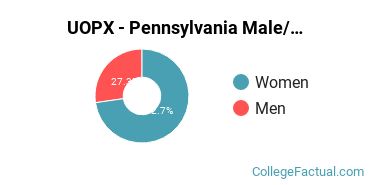
For the gender breakdown for all students, go here.
UOPX - Pennsylvania Racial/Ethnic Breakdown of Undergraduates
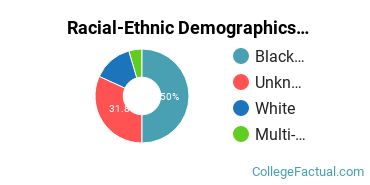
| Race/Ethnicity | Number |
|---|---|
| Black or African American | 11 |
| Unknown | 7 |
| White | 3 |
| Multi-Ethnic | 1 |
| Hispanic | 0 |
| Native Hawaiian or Pacific Islander | 0 |
| International | 0 |
| Asian | 0 |
See racial/ethnic breakdown for all students.
Below Average Racial/Ethnic Diversity
UOPX - Pennsylvania is ranked 3,039 out of 3,790 when it comes to the racial/ethnic diversity of the students.
Some schools are low in racial/ethnic diversity due to catering to one specific racial/ethnic group, or because they are located in an area where they primarily serve the nearby community.
UOPX - Pennsylvania Racial Demographics:
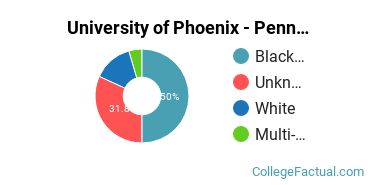
| Race/Ethnicity | Number |
|---|---|
| Black or African American | 11 |
| Unknown | 7 |
| White | 3 |
| Multi-Ethnic | 1 |
| Hispanic | 0 |
| Native Hawaiian or Pacific Islander | 0 |
| International | 0 |
| Asian | 0 |
High Racial/Ethnic Diversity Among Faculty
University of Phoenix - Pennsylvania Faculty Racial/Ethnic Demographics:
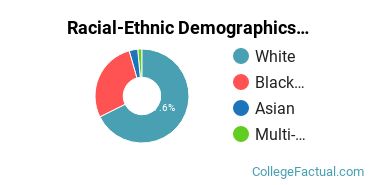
| Ethnicity | Number of Faculty |
|---|---|
| White | 46 |
| Black or African American | 19 |
| Asian | 2 |
| Multi-Ethnic | 1 |
| Hispanic | 0 |
| Native Hawaiian or Pacific Islander | 0 |
| International | 0 |
| Unknown | 0 |
Learn more about the faculty at UOPX - Pennsylvania.
Average Male/Female Ratio
UOPX - Pennsylvania ranks 2,993 out of 3,790 when it comes to gender parity on campus.
This school is more popular with women than with men.
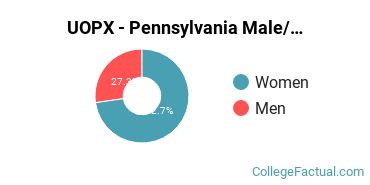
There are approximately 16 female students and 6 male students at UOPX - Pennsylvania.
Even Balance of Male & Female Teachers
Reporting of the gender of UOPX - Pennsylvania is unknown or unavailable.
There are more male teachers than female teachers at this school.
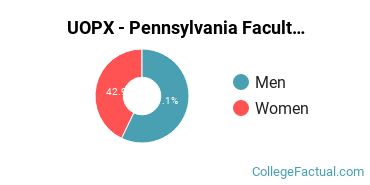
More about UOPX - Pennsylvania faculty.
There are approximately 30 female teachers and 40 male teachers.
Low Geographic Diversity
UOPX - Pennsylvania ranks 2,181 out of 2,183 when it comes to geographic diversity.
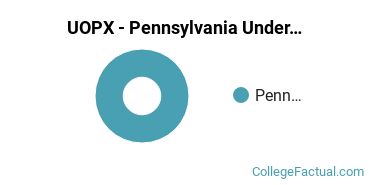
The undergraduate student body is split among 1 states (may include Washington D.C.). Click on the map for more detail.
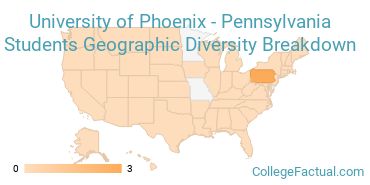
Top 5 States
| State | Amount |
|---|---|
| Pennsylvania | 3 |
| Alaska | 0 |
| Arkansas | 0 |
| Arizona | 0 |
| California | 0 |
High Student Age Diversity
A traditional college student is defined as being between the ages of 18-21. At UOPX - Pennsylvania, 0.70% of students fall into that category, compared to the national average of 60%.
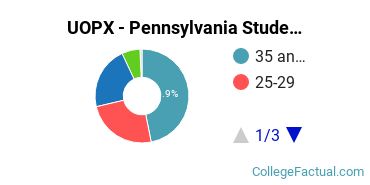
| Student Age Group | Amount |
|---|---|
| 35 and over | 67 |
| 25-29 | 35 |
| 30-34 | 31 |
| 22-24 | 9 |
| 20-21 | 1 |
| 18-19 | 0 |
| Under 18 | 0 |
Notes and References
Footnotes
*The racial-ethnic minorities count is calculated by taking the total number of students and subtracting white students, international students, and students whose race/ethnicity was unknown. This number is then divided by the total number of students at the school to obtain the racial-ethnic minorities percentage.
References
-
Department of Homeland Security Citizenship and Immigration Services
-
Read College Factual's Diversity Ranking Methodology.

